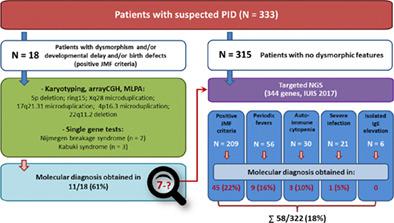当前位置:
X-MOL 学术
›
Clin. Genet.
›
论文详情
Our official English website, www.x-mol.net, welcomes your
feedback! (Note: you will need to create a separate account there.)
Next generation sequencing analysis of consecutive Russian patients with clinical suspicion of inborn errors of immunity.
Clinical Genetics ( IF 2.9 ) Pub Date : 2020-05-22 , DOI: 10.1111/cge.13789 Evgeny N Suspitsin 1, 2 , Marina N Guseva 3, 4 , Mikhail M Kostik 5 , Anna P Sokolenko 1, 2 , Nataliya V Skripchenko 6, 7 , Anastasia S Levina 6 , Olga V Goleva 8 , Margarita F Dubko 5 , Anastasia V Tumakova 1 , Maria A Makhova 1 , Lidiya V Lyazina 9 , Ilya V Bizin 2 , Natalia E Sokolova 10 , Tatiana V Gabrusskaya 11 , Liliya V Ditkovskaya 12 , Olga P Kozlova 13 , Svetlana S Vahliarskaya 14 , Irina V Kondratenko 14 , Evgeny N Imyanitov 1, 2, 15, 16
Clinical Genetics ( IF 2.9 ) Pub Date : 2020-05-22 , DOI: 10.1111/cge.13789 Evgeny N Suspitsin 1, 2 , Marina N Guseva 3, 4 , Mikhail M Kostik 5 , Anna P Sokolenko 1, 2 , Nataliya V Skripchenko 6, 7 , Anastasia S Levina 6 , Olga V Goleva 8 , Margarita F Dubko 5 , Anastasia V Tumakova 1 , Maria A Makhova 1 , Lidiya V Lyazina 9 , Ilya V Bizin 2 , Natalia E Sokolova 10 , Tatiana V Gabrusskaya 11 , Liliya V Ditkovskaya 12 , Olga P Kozlova 13 , Svetlana S Vahliarskaya 14 , Irina V Kondratenko 14 , Evgeny N Imyanitov 1, 2, 15, 16
Affiliation

|
Primary immune deficiencies are usually attributed to genetic defects and, therefore, frequently referred to as inborn errors of immunity (IEI). We subjected the genomic DNA of 333 patients with clinical signs of IEI to next generation sequencing (NGS) analysis of 344 immunity‐related genes and, in some instances, additional genetic techniques. Genetic causes of the disease were identified in 69/333 (21%) of subjects, including 11/18 (61%) of children with syndrome‐associated IEIs, 45/202 (22%) of nonsyndromic patients with Jeffrey Modell Foundation (JMF) warning signs, 9/56 (16%) of subjects with periodic fever, 3/30 (10%) of cases of autoimmune cytopenia, 1/21 (5%) of patients with unusually severe infections and 0/6 (0%) of individuals with isolated elevation of IgE level. There were unusual clinical observations: twins with severe immunodeficiency carried a de novo CHARGE syndrome‐associated SEMA3E c.2108C>T (p.S703L) allele; however, they lacked clinical features of CHARGE syndrome. Additionally, there were genetically proven instances of Netherton syndrome, Х‐linked agammaglobulinemia, severe combined immune deficiency (SCID), IPEX and APECED syndromes, among others. Some patients carried recurrent pathogenic alleles, such as AIRE c.769C>T (p.R257*), NBN c.657del5, DCLRE1C c.103C>G (p.H35D), NLRP12 c.1054C>T (p.R352C) and c.910C>T (p.H304Y). NGS is a powerful tool for high‐throughput examination of patients with malfunction of immunity.
中文翻译:

对临床怀疑患有先天性免疫缺陷的连续俄罗斯患者进行下一代测序分析。
原发性免疫缺陷通常归因于遗传缺陷,因此通常被称为先天性免疫缺陷(IEI)。我们对 333 名具有 IEI 临床症状的患者的基因组 DNA 进行了 344 个免疫相关基因的下一代测序 (NGS) 分析,在某些情况下还使用了其他遗传技术。 69/333 (21%) 的受试者中发现了该疾病的遗传原因,其中 11/18 (61%) 患有与综合征相关的 IEI 儿童,45/202 (22%) 的杰弗里·莫德尔基金会 (JMF) 非综合征患者) 警告信号,9/56 (16%) 的受试者患有周期性发热,3/30 (10%) 的自身免疫性血细胞减少病例,1/21 (5%) 的患者患有异常严重的感染,0/6 (0%) )存在 IgE 水平孤立升高的个体。存在不寻常的临床观察结果:患有严重免疫缺陷的双胞胎携带与新生 CHARGE 综合征相关的SEMA3E c.2108C>T (p.S703L) 等位基因;然而,他们缺乏 CHARGE 综合征的临床特征。此外,还存在经基因证实的 Netherton 综合征、Х 相关无丙种球蛋白血症、严重联合免疫缺陷 (SCID)、IPEX 和 APECED 综合征等病例。一些患者携带复发性致病等位基因,例如AIRE c.769C>T (p.R257*)、 NBN c.657del5、 DCLRE1C c.103C>G (p.H35D)、 NLRP12 c.1054C>T (p.R352C)和 c.910C>T (p.H304Y)。 NGS 是对免疫功能障碍患者进行高通量检查的有力工具。
更新日期:2020-05-22
中文翻译:

对临床怀疑患有先天性免疫缺陷的连续俄罗斯患者进行下一代测序分析。
原发性免疫缺陷通常归因于遗传缺陷,因此通常被称为先天性免疫缺陷(IEI)。我们对 333 名具有 IEI 临床症状的患者的基因组 DNA 进行了 344 个免疫相关基因的下一代测序 (NGS) 分析,在某些情况下还使用了其他遗传技术。 69/333 (21%) 的受试者中发现了该疾病的遗传原因,其中 11/18 (61%) 患有与综合征相关的 IEI 儿童,45/202 (22%) 的杰弗里·莫德尔基金会 (JMF) 非综合征患者) 警告信号,9/56 (16%) 的受试者患有周期性发热,3/30 (10%) 的自身免疫性血细胞减少病例,1/21 (5%) 的患者患有异常严重的感染,0/6 (0%) )存在 IgE 水平孤立升高的个体。存在不寻常的临床观察结果:患有严重免疫缺陷的双胞胎携带与新生 CHARGE 综合征相关的SEMA3E c.2108C>T (p.S703L) 等位基因;然而,他们缺乏 CHARGE 综合征的临床特征。此外,还存在经基因证实的 Netherton 综合征、Х 相关无丙种球蛋白血症、严重联合免疫缺陷 (SCID)、IPEX 和 APECED 综合征等病例。一些患者携带复发性致病等位基因,例如AIRE c.769C>T (p.R257*)、 NBN c.657del5、 DCLRE1C c.103C>G (p.H35D)、 NLRP12 c.1054C>T (p.R352C)和 c.910C>T (p.H304Y)。 NGS 是对免疫功能障碍患者进行高通量检查的有力工具。











































 京公网安备 11010802027423号
京公网安备 11010802027423号